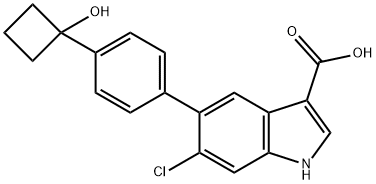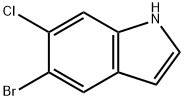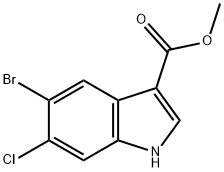
6-chloro-5-(4-(1-hydroxycyclobutyl)phenyl)-1H-indole-3-carboxylicacid synthesis
- Product Name:6-chloro-5-(4-(1-hydroxycyclobutyl)phenyl)-1H-indole-3-carboxylicacid
- CAS Number:1467057-23-3
- Molecular formula:C19H16ClNO3
- Molecular Weight:341.79
![1H-Indole-3-carboxylic acid, 6-chloro-5-[4-(1-hydroxycyclobutyl)phenyl]-, methyl ester](/CAS/20210305/GIF/1467059-92-2.gif)
1467059-92-2

1467057-23-3
Methyl 6-chloro-5-[4-(1-hydroxycyclobutyl)phenyl]-1H-indole-3-carboxylate (131 g, 368 mmol), methanol (2.20 L), and an aqueous sodium hydroxide solution (90.2 g, 2.21 mol, dissolved in 740 mL of water) were added to a round bottom flask, and the reaction was stirred for 18 hours at 70 °C. Upon completion of the reaction, the mixture was cooled to room temperature, filtered through diatomaceous earth, and the filtrate was concentrated to approximately 30% of the original volume, at which time no precipitate formation was observed. After addition of water (700 mL), the clarified tan solution was washed with methyl tert-butyl ether (MTBE, 3 x 250 mL) and the organic layer was discarded. 38% hydrochloric acid (200 mL) was added dropwise to the stirred aqueous phase (total volume of about 1800 mL) to a pH of about 2-3 at 18-25°C, followed by a one-time addition of ethyl acetate (250 mL). Upon addition of ethyl acetate, solids began to precipitate. Heptane (250 mL) was slowly added to the stirred non-homogeneous mixture via an addition funnel at room temperature and stirring was continued for 4 hours. The solid was collected by filtration, washed sequentially with water and ethyl acetate-heptane mixture (1:1), dried by filtration at room temperature and dried under vacuum at 50 °C to give a light yellow solid. The solid was dissolved in tetrahydrofuran (630 mL) and stirred at 65 °C (internal temperature) for 4 h. Ethyl acetate (630 mL) was then slowly added through a dropping funnel and the resulting slurry was slowly cooled at room temperature overnight. The solid was filtered, washed with a tetrahydrofuran-ethyl acetate mixture (1:1) and dried under vacuum at 50 °C to give 107.0 g of product. The mother liquor was concentrated and the residue was washed with acetone, filtered and dried to give another 12.5 g of product. The resulting solid was dissolved in ethanol (800 mL) containing 0.3 mL of 1M NaOH aqueous solution, and water (800 mL) was slowly added through a dosing funnel at 55-60 °C, and a precipitate began to form after the addition of water. The suspension was stirred at 60 °C for 2 h, followed by stirring at 40 °C for 24 h, and finally for 40 h at room temperature. The solid was filtered, washed with an ethanol-water mixture (1:1) and dried under vacuum at 50 °C to afford 6-chloro-5-(4-(1-hydroxycyclobutyl)phenyl)-1H-indole-3-carboxylic acid as an off-white crystalline solid (72.4 g, 58% yield). The mother liquor was concentrated to about 30% of the original volume, precipitate was precipitated, filtered and dried in vacuum to give another batch of product (14.5 g, 12% yield). The total yield was 70%. Mass spectrum (ES-): m/z 340.3 ([M-H]-). 1H NMR (400 MHz, DMSO-d6) δ: 12.12 (s, 1H), 11.95 (br.s, 1H), 8.09 (d, 1H), 7.96 (s, 1H), 7.65 (s, 1H), 7.58 (d, 2H), 7.42 (d, 2H). 5.53 (s, 1H), 2.48-2.42 (m, 2H), 2.32 (m, 2H), 1.96 (tq, 1H), 1.62-1.79 (m, 1H).
![Ethanamine, N-[(3,5-dichlorophenyl)methylene]-2,2-diethoxy-](/CAS/20210305/GIF/1000210-73-0.gif)
1000210-73-0
0 suppliers
inquiry

1467057-23-3
72 suppliers
$25.00/1mg
Yield: 71%
Reaction Conditions:
with sodium chlorite;sodium dihydrogen phosphate monohydrate;2-methyl-but-2-ene in water;acetonitrile;tert-butyl alcohol at 20; for 22 h;
Steps:
1.4 6-Chloro-5-(4-(1-hydroxycyclobutyl)phenyl)-1H-indole-3-carboxylic acid
To a solution of 6-chloro-5-[4-(1-hydroxy-cyclobutyl)-phenyl]-1H-indole-3-carbaldehyde (4.88 g, 15.0 mmol) in MeCN (212 mL) and tert-butanol (212 mL) at 0° C. was added 2-methyl-2-butene (120 mL, 1.15 mol), followed by a solution of sodium chlorite (25.5 g, 300 mmol) and sodium phosphate monobasic hydrate (42.5 g, 308 mmol) in water (212 mL) dropwise via addition funnel.
The ice bath was removed and the reaction mixture was stirred vigorously at room temperature.
After 13 hours, additional 2-methyl-2-butene (50 mL, 480 mmol) was added, followed by sodium chlorite (10.6 g, 125 mmol) and sodium phosphate monobasic hydrate (17.7 g, 125 mmol) as solids.
The reaction mixture was stirred at room temperature for an additional 5 hours, and treated with additional 2-methyl-2-butene (25 mL, 240 mmol), solid sodium chlorite (5.3 g, 73 mmol) and solid sodium phosphate monobasic hydrate (8.8 g, 73 mmol).
After an additional 4 hours, the reaction mixture was poured into a 4:1 mixture of saturated aqueous NH4Cl solution/water (500 mL), and extracted with EtOAc (3*400 mL).
The combined organic layers were dried over Na2SO4 and concentrated in vacuo.
The resulting material was loaded onto a silica gel plug and eluted, first with heptane/EtOAc (4:1, 1.5 L), followed by 1:4 heptane/EtOAc (3 L) then EtOAc (1 L).
The filtrates from the second and third elutions were combined and concentrated in vacuo.
The resulting tan solid was partially dissolved in 4:1 DMF/DCM, loaded onto an Isco silica gel cartridge, and purified by flash chromatography (20-80% EtOAc/heptane, with 0.2% formic acid modifier) to give the title compound (3.65 g, 71%) as a white solid. MS (ES+) 340.2 (M-H)+. 1H NMR (500 MHz, DMSO-d6) δ 12.10 (s, 1H), 11.95 (s, 1H), 8.08 (s, 1H), 7.95 (s, 1H), 7.64 (s, 1H), 7.57 (d, J=7.1 Hz, 2H), 7.41 (d, J=7.1 Hz, 2H), 5.52 (s, 1H), 2.48-2.40 (m, 2H), 2.35-2.26 (m, 2H), 1.97-1.90 (m, 1H), 1.76-1.62 (m, 1H).
References:
PFIZER INC.;Bhattacharya, Samit;Cameron, Kimberly;Dowling, Matthew;Fernando, Dilinie;Ebner, David;Filipski, Kevin;Kung, Daniel;Lee, Esther;Smith, Aaron;Tu, Meihua US2013/267493, 2013, A1 Location in patent:Paragraph 0696; 0700
![Ethanamine, N-[(3,5-dichlorophenyl)methylene]-2,2-diethoxy-](/CAS/20210305/GIF/1000210-73-0.gif)
1000210-73-0
0 suppliers
inquiry

1467057-23-3
72 suppliers
$25.00/1mg

19936-14-2
70 suppliers
$43.00/100mg

1467057-23-3
72 suppliers
$25.00/1mg

122531-09-3
127 suppliers
$7.00/100mg

1467057-23-3
72 suppliers
$25.00/1mg

1467059-91-1
38 suppliers
$505.85/5MG
![[4-(1-hydroxycyclobutyl)phenyl]boronic acid](/CAS/20200331/GIF/1467062-11-8.gif)
1467062-11-8
11 suppliers
inquiry

1467057-23-3
72 suppliers
$25.00/1mg